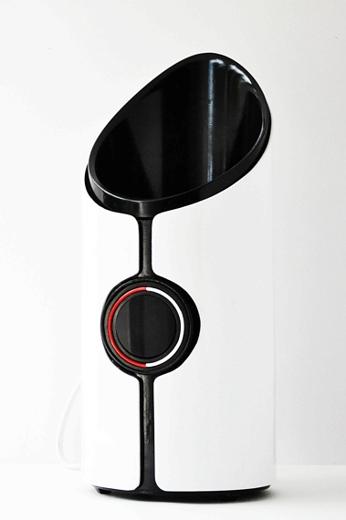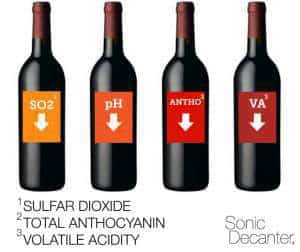Sonic Youth Decanted, or how we ended up in the Washington Post
On December 10th, we were featured in a Washington Post Online article disputing the claims made about the Sonic Decanter. The article is fair and comprehensive. It is a much-needed antidote to the marketing bromides that have been swirling around the Sonic Decanter for the last few months.
Our involvement in the story began with this blog post, which was originally published on November 24th. I wrote this article after Will Kanaley posed a question about the device on our “Ask Us Anything” forum. Prompted by Will, I looked into the Sonic Decanter and its marketing claims. I did not like what I saw or how the media was drinking up the marketing claims with little if any of their normal skepticism. My research turned into this blog post, and what I found was pretty damning.
We got some social media love and a few angry mentions (of course) in a forum or two. Within a few days, Tuan Nguyen of the Washington Post called me up. I talked with Tuan for several hours about my concerns with the Sonic Decanter. The article he wrote is well worth a read.

My original post starts here:
Wine Gadgets
Every few years, a new wine gadget is invented. In 2005, there was the “Wine Magnet” its marketing stated that it would ” improve the taste of wine… making it smoother, less bitter and more refined… aging wine to perfection.” In 2007 came the “Wine Aerator” with its promise of adding oxygen to wine as you drank it (as if this didn’t happen already because, you know, science). Dozens of proprietary wine glasses and decanters have come our way, all with claims to make wine taste better than it should. At the Wine School, we have disproved all these contraptions, and in classes, like Sommelier Secrets, we show how absurd their claims are.

Sonic Decanter
Recently, a new wine gadget has popped up on Kickstarter. It’s called the Sonic Decanter. As of this writing, it’s met its funding goal, and in fact, has exceeded that goal by nearly 200%. The popularity of this device has been spurred on by articles in Huffington Post, CNET, The Times, and Gizmodo. Most of the articles extolled the virtues of the device, saying it made wine taste better. Sadly, none of the journalists took a hard enough look at the creator’s claims.
How the Sonic Decanter Works
The creators of the device claim that it uses sonochemistry to change the molecular structure of the wine. In other words, the device shoots ultrasound waves into the wine to alter flavor compounds. They claim this change is beneficial to the taste.
They claim the device lowers several naturally occurring elements in wine, including sulfur dioxide, anthocyanins, and volatile acidity. They also claim to reduce the pH of the wine, as well. Here is the chart they include on their Kickstarter campaign:

Here are the claims from various sections of their kickstarter page:
When used on wine the Sonic Decanter® promotes further extraction of flavors, aromas and mouth feel from interactions among phenolics and anthocyanins which results in smoother more integrated mouth feel and a smooth, flavorful lingering finish.
When using the Sonic Decanter®, wine becomes a more homogeneous liquid with improved sensory characteristics and an improved open bottle “shelf life” in a very short time of treatment. Using the Sonic Decanter® allows for a more energetic reaction between the molecules and thus a more complete molecular change. In addition the natural gases including oxygen and sulfur dioxide (SO2) are expelled from the bottle, pH is reduced and other components are modified.
There is no specific time limit for drinking the wine after improvement with the Sonic Decanter. We have had wine that was treated, tasted them re-corked and found the same wonderful characteristics 4-6 days later. Of course this requires that the wine be re-corked and stored properly between tastings.
The Sonic Decanter applies optimized levels of both pressure and temperature via ultrasonic energy. The process is conducted independent of external temperatures and pressures and provides a means of obtaining changes in molecular structure, at microsecond intervals, in microscopic areas throughout the liquid. The complete agglomeration of wine components results in a smoother taste and enhanced overall wine experience. Moreover, the stability of the molecular change extends the peak periods of taste and bouquet increasing the drinkable shelf life of the wine.
Sonic Decanter’s Kickstarter
Let’s break this all down and see if the claims hold up. To be clear, I have not used the machine in question. I am relying on the Sonic Decanter Kickstarter page. If the people behind Sonic Decanter have more technical information about the product, I would gladly re-examine this issue. However, from what I have seen, I believe their claims to be dubious.
Reduces sulfur dioxide
This is technically true, but this already happens when you open the bottle. Also, they didn’t even bother fixing the typo (sulfar dioxide) on their image.
Reduces oxygen levels from wine.
This claim makes little sense. O2 levels in wine are microscopic. In fact, their claim that oxygen is pushed out of the wine would negatively impact the flavor of wine: exposure to oxygen is the single most important factor in increasing wine flavors when opening a bottle of wine. This is why sommeliers decant wines.
Reduces (or changes) levels of anthocyanins
Anthocyanins are the pigmentation of red wine. Along with other polyphenols, they give red wine the sensation of dryness and texture in red wines. If it actually changed the type or quality of the anthocyanins, the biggest difference would be the color of the wine.
Softens the tannins
Wine gadget promoters typically proclaim that their devices “soften” red wine flavors. This is very easy to do. Heat the wine in a microwave for 30 seconds setting will do the same thing. Shooting the wine through a blender will do the same thing. Or (on my strong recommendation) simply opening the bottle for an hour before drinking will do the same thing.
pH is reduced
To reduce pH means the machine is making the wines more acidic. This isn’t impossible, but it doesn’t jibe with their other claims. It would make the wine taste sharper and crisper, not rounder or fuller. It would make flaws in lower-priced wines more noticeable.
Improve shelf life
This claim seems impossible on its face. Breaking down anthocyanins and altering their acid levels can only reduce their ability to stave off oxidization and infections. It would only work if it totally neutralized the wine, destroying most biological elements in the wine. Of course, flavor in wine is biological in origin…
Reduces Volatile Acids
These are not present in any meaningful way in the wine. This was a problem in inexpensive wine 20 years ago, but it’s very rare today.
For any journalist who wants to test Sonic Decanter, please follow my standard rule in testing wine gadgets: as in any scientific study, there must be a control subject. That control subject MUST always be a bottle of the same wine, decanted an hour before and served at 65 degrees Fahrenheit.

I bought one and it failed after a I used it a few times.
Have tried contacting the company but no response
Total waste of money
Sorry to hear that. Let us know if they ever respond.
I am disappointed to hear this (I had high hopes), but your arguments are sound. However, I must take exception to this part:
“Take two bottles of the same wine. Submerge one in boiling water for 10 minutes, and put the other into the sonic decanter.”
For a proper comparison test, there must always be a control; i.e., one that has not been altered in any way. You can compare this control to as many variants as you like; but I would venture to say that the only way one can unequivocally state that the device does not improve a wine’s taste is to compare “device” and “non-device” wine directly.
Pamela,
You are quite correct that having a control is the only way to properly test the claims made by the manufacturer. Thank you for your input!
above and beyond whether the decanter works or not, I purchased one and it broke within a few months. I have tried to contact the company to fix it but there was no reply. Buyer beware
Thank you for letting us know!
I’m confused by your reply to the original comment here as it states in the blog that you have not tried the device yourself but btl you say you have and that it was the basis for the article linked. Having read that article I can see no mention of the double blind test to which you refer but it does quote you as saying “sound waves can alter the makeup and taste of wine in a way that makes it more palatable momentarily for some”. I’m not saying the device works (I’m sceptical myself) just that perhaps you could detail the test you mention and clarify whether you have tried it yourself.
When I originally wrote this piece, it. Was a response to the pseudo-science being tossed about in the sonic decanter kickstarter page.
After that, a journalist for WaPo reached out, and I was his primary source for the eventual article.
At that time, I got my hands on the machine and ran a double blind test. The machine failed to show any benefits. I ended up not following up on the tests, since interest around the subject had faded. Apparently, there is some renewed interest. I will update this article with the outcome of that experiment.
If you want to test it yourself, then I’d recommend the following:
Take two bottles of the same wine. Submerge one in boiling water for 10 minutes, and put the other into the sonic decanter.
Let both sit overnight, and have a friend pour you a glass of each. Both wines will taste the same, because the same chemical reactions have taken place. And that reaction is not a positive one: the machine seems to damage wines in the same way that boiling it does.
Has the author of this article even tried a Sonic Decanter??? “For any journalist who wants to test Sonic Decanter, please follow my standard rule in testing wine gadgets” AND TRY THE ACTUAL PRODUCT YOU ARE WRITING ABOUT :-)
Chad,
Yes. It was tested in a double-blind format. It was shown to be a hoax. This was the basis for the Wall Street Journal article:
https://www.washingtonpost.com/news/innovations/wp/2014/12/10/can-sound-waves-actually-make-wine-taste-better/